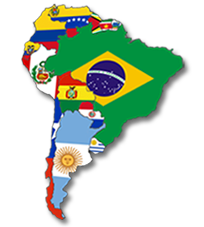Focus on Latin America: Transportation and Regulatory Infrastructure
Before entering this vibrant marketplace, trade experts advise logistics managers to conduct a careful examination of the region’s transportation and regulatory infrastructure.
The 2013 A.T. Kearney Foreign Direct Investment Confidence Index, a regular measure of senior executive sentiment at the world’s largest companies, indicates that Latin America remains attractive to U.S. shippers and manufacturers.
Furthermore, key emerging economies in the Americas are making a strong showing in the investment landscape this year, with Chile, Argentina, and Mexico joining Brazil in the top 25.
“Rather than a temporary safe haven during economic upheaval, emerging markets – particularly in Latin America – are developing into a complement, instead of an alternative, to the developed world,” notes Erik Peterson, managing director of A.T. Kearney’s Global Business Policy Council.
Brazil maintained its third place position in the FDICI this year. In 2011, its FDI hit $66.7 billion, its highest level ever and a 37 percent increase since 2010. More inflows are likely on the way, with the 2014 World Cup and 2016 Olympics needing transportation and infrastructure investments of $200 billion. Manufacturing remains the recipient of nearly half of Brazil’s FDI, with European, Scandinavian and Chinese investors all adding billions to its economy.
But before entering this vibrant marketplace, trade experts advise logistics managers to conduct a careful examination of the region’s transportation and regulatory infrastructure.
“Given sociopolitical and economic forces that seem only to be racking up new surprises each year,” Peterson says, “investors in developed economies and emerging countries alike will need to find nimble strategies to deal with this shifting landscape.”
Weak Infrastructure
The benefits of logistics investments in the region have been addressed recently by the Inter-American Development Bank’s Department of Infrastructure and Environment.
Jean-Paul Rodrigue, professor, Department of Global Studies & Geography, at Hofstra University in New York, observes that transportation is an inherently crucial factor in supporting trade activities as well as providing opportunities for economic development.
“Yet, this focus can be perceived as a bias as it overlooks the complex structure and organization of freight flows that characterize global supply chains,” he says. “While transport infrastructures remain a fundamental component of economic development strategies, the approach must be expanded to consider the freight distribution requirements for both domestic commercial activities and the global economy.”
This means that transport infrastructure capacity may have limited value if not supported by a proportional level of reliability and timeliness in freight distribution supported by transport services, adds Rodrigue.
“Latin American and Caribbean ports have seen a remarkable growth of the containerized traffic handled with the development and expansion of port infrastructure,” he says. “The conventional role of a resource exporter, such as agricultural and mining products, is being expanded through an increasing sophistication of imports and exports.”
According to Rodrigue, port facilities and their hinterland have responded with infrastructure investments with a well-founded anticipation of additional traffic growth. Within this new environment where Latin American and Caribbean economies are expanding their horizon, freight transport and logistics investment must be seen as a joint and interdependent endeavor. Transport infrastructure capacity must be accompanied with freight logistics reliability, effectiveness and resilience.
Yet Latin America’s port infrastructure is still rated “below average” by the World Bank. Channel capacity at most ports is insufficient, with productivity and berthing delays a continuing issue. And with larger ocean cargo vessels being introduced to the trade next year, analysts say there’s a new urgency for needed port upgrades.
“Ocean carriers seek economies of scale to offset rising energy costs,” says Stephen Fletcher of Alphaliner, a London-based consultancy. “These mega ships will soon represent almost half of the global order book.”
Meanwhile, Latin American’s exports are growing, but their share of domestic GDP is low, notes Moffatt & Nichol chief economist, Walter Kemmsies.
“Infrastructure investment lowers costs and can raise downstream industrial exports while lowering commodity price inflation,” he adds. “The Panama Canal expansion and other infrastructure are needed to raise region’s share of contribution and global economic activity.”

More on Latin America
- A Renewed Look at Doing Business in Latin America
- América Latina: Opportunities Abound, but Proceed with Care
- Focus on Latin America: Transportation and Regulatory Infrastructure
- Focus on Latin America: Brazil, Argentina, Chile
- Focus on Latin America: The Seaborne Advantage
- Doing Business 2014: Latin America (paper)
Article Topics
The World Bank News & Resources
Increased Policy Uncertainty & Maturing Global Value Chains Weakened 2016 Trade Growth Trade Developments in 2016 U.S. Oil Closes Below $40 a Barrel for 1st Time in Nearly 4 Months Crude Oil Crashes Below $30 a Barrel for the First Time in 12 Years Understanding the Plunge in Oil Prices: Sources and Implications Customer-Driven Rail Intermodal Logistics: Unlocking a New Source of Value for China Containers on Rail: China’s Next Big Opportunity in Supply Chain Logistics More The World BankLatest in Supply Chain
Trucking Industry Pushes Back on Government’s Electric Mandates Senators Take Aim at Amazon with Warehouse Worker Protection Act Maersk Sees Silver Lining in Red Sea Shipping Challenges Happy Returns Partners With Shein and Forever 21 to Simplify Returns Baltimore Opens 45-Foot Deep Channel Following Bridge Collapse El Paso Border Delays Cost Juarez $32 Million Per Day in Economic Losses Ranking the World’s 10 Biggest Supply Chains More Supply ChainAbout the Author














